One of the world’s most ubiquitous building materials may also strangely be one of the world’s most underappreciated. Able to withstand everyday foot traffic, the worst of weather, and the constant passage of time better than almost any material there is – concrete has become an indispensable part of the human experience.
“I love traveling and seeing how other cultures have identified with concrete,” said Ben Feldmann, a landscape architect and urban designer at Studio-MLA in Los Angeles, CA. Through more than 25 years of experience, Feldmann has designed landscapes of every scale from courtyards to city parks and everything in between. As a principal at Studio-MLA, today Feldmann finds himself working with a talented team of professionals to tackle some of the largest, most high-profile opportunities in the public realm. The recently completed Banc of California Stadium, home to the Los Angeles Football Club (LAFC) of Major League Soccer, is an excellent example of how design can respond to both ends of the scale – micro and macro – and how concrete can be the constant connection between them.

“The Banc of California Stadium is a major urban anchor intended to improve a corridor, connect to Exposition Park, and pay homage to the recently demolished L.A. Memorial Sports Arena,” said Feldmann. “That’s a big assignment with a lot of little details. The threads that connect the stadium to the city are thoughtful design and the hardscape materials.”
Located on the southeast corner of Exposition Park, the stadium joins a collection of world-class museums, entertainment venues, gardens, green space, and dining on a sprawling 160-acre campus that is a crossroads of the Los Angeles community. The site work package included approximately 140,000ft2 of concrete in a variety of types and forms. The design logically funnels spectators toward the stadium’s three corner entrances while addressing edge conditions and contributing to Exposition Park’s larger context of both active and passive uses.
“By virtue of budgets, decorative concrete as a design element has to be used judiciously,” said Feldmann. Studio-MLA identified the stadium’s entrances as areas to enhance with the highest-appeal decorative concrete design elements. “We worked with Bomel Construction to consider a lot of options and the end result is a very nice celebration of the whole Los Angeles Football Club experience.”
Shawn Devine loves concrete as well, it’s in his blood. Devine leads Bomel’s architectural and site division and has worked with concrete for 31 of his 54 years. Bomel is one of the largest concrete contractors in the US, building structural solutions for office towers, hotels, and parking structures along with both decorative and traditional flat work. Devine joined Bomel in 2011 to lead the architectural and site division. Today, Devine and the Bomel Construction team are delivering some of the most complex, high-profile architectural concrete projects in Southern California.

“We started pricing the stadium’s site work back in August of 2015. The hardscape started out as pavers, and that wasn’t cost-effective,” said Devine. Over eight rounds of cost estimating in support of general contractor, PCL Construction, Devine’s team helped work through a variety of design alternatives before ultimately deciding on cast-in-place concrete as the primary building material. Working with the ownership team and designers at Gensler, the team scrutinized formwork layouts, rebar patterns, material choices, and saw cut pattering to deliver a beautiful design solution that could be built at a cost that worked within PCL’s Guaranteed Maximum Price.
“We incorporated three different Bomanite products, a heavy dose of craftsmanship, and Bomel’s commitment to quality and durability,” said Devine of the materials selected and the contracted scope. Bomel is part of a nation-wide network of Bomanite licensed contractors who share information, resources, expertise, and a commitment to exceptional craftsmanship in their work. Bomanite works with licensees to research and develop acute material mixes tailored to project specifics like team colors, local or exotic aggregates, coloring, and finishing techniques.
A proprietary mix of Bomanite’s Exposed Aggregate Sandscape in a San Diego Buff color was used to enhance the pedestrian experience at entrances, on benches, and as planter walls for trees and shrubs throughout plazas and on the roof deck landing. Clear and mirror glass flakes were broadcasted onto nearly 50,000 square feet at three entry plazas to add luster and friction to integrally colored concrete in LAFC hues. Spectator queuing is intuitively integrated underfoot as bands of Bomanite’s Exposed Aggregate Alloy in Cobblestone grey lead fans to ticket takers. A perimeter of Bomanite’s 11.5” Boardwalk imprint was also used to frame a raised seating area supporting the stadium’s food court.
One of the site’s most unusual design elements is the Flight Wall, a sculpted wall of fluted angels’ wings used to add prominence to a raised event podium. Cast in a one-of-a-kind, CNC-routed form liner, the concrete had to be poured along two feet of slope, and cure in place before the liner was released and peeled away.
“We take pride in delivering on big expectations, and Bomanite products are an important part of that,” said Devine. Being a team player, coming to the table with issues, solutions, and a willingness to collaborate is essential to success on high-profile, mega projects. Reliable, durable, beautiful Bomanite decorative concrete products are well-known and trusted by architects and landscape architects around the world.
“We rely on quality materials to bring a high-impact design to life. Bomanite is an industry leader in decorative concrete and lives up to expectations,” concluded Feldmann. “The Banc of California Stadium was a true test of everyone’s creativity, craftsmanship, and experience on a grand scale. The result is a thing of beauty.”





